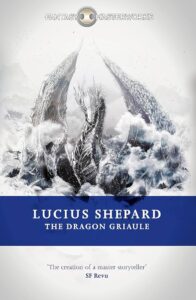Before Lucius Shepard had published stories, he had the idea of a dragon who was 6,000 feet long, immobilized but not killed by a wizard’s spell ages ago, now more or less a part of the landscape with towns and villages on and around his body, which was difficult to distinguish from the other hills of the region. This was the dragon Griaule, to whom Shepard would return throughout his career: the first story in the collection, “The Man Who Painted the Dragon Griaule,” was published in 1984; the last, “The Skull,” appeared in 2012, two years before Shepard’s own death. Throughout the stories, Griaule is vast and still, but awake, and malevolent. Some characters perceive his presence as part of the general atmosphere in the places built on his body. Others think that they have more direct access to his will, or perhaps vice versa.
The stories begin in the register of fantasy tales, with perhaps a bit of industrialization peeking over the temporal horizon. Early on, the towns also want to rid themselves of Griaule’s influence and become more or less normal places. Later, the populace of places close to Griaule appear to have accepted their lot, and some even to revel in it. In the first story, the titular man is a painter who has not met with much commercial success. When he hears of the offer by the town of Teocinte to give a vast sum to anyone who can finally kill Griaule, Meric Cattanay sees an opportunity for a great plan, or maybe a great scam. Griaule will become an enormous canvas, Teocinte will become home to a wonder of art, and the action of the paints will become the dragon’s end, chemicals finally doing what sorcery could not. Shepard sketches the decades that pass, until finally
You decided to paint a dragon, to send hundreds of men searching for malachite and cochineal beetles, to love a woman, to heighten an undertone here and there, and finally to position your body a certain way. He seemed to have reached the end of the process. What next? (p. 29)
Who has outlasted whom?
In later stories, there are cultists who worship Griaule, there are people stranded in his innards for years, eventually even another dragon in another guise. Shepard’s prose is as lush and poetic as I remembered from long-ago readings of Life During Wartime or The Jaguar Hunter. He gets in some great lines, like the story that ends “…she lived happily ever after. Except for the dying at the end. And the heartbreaks in between.” (p. 112) Griaule is a singular creation, backdrop for the stories’ action, but also projection of the characters’ views. His scale and scales give the collection its unity.
At the end, though, I felt more distanced from Shepard’s work than I had hoped. Part of this is that my tolerance has dimmed for characters driven by fate, characters who speak of unseen influences, strange compulsions. I see the authorial hand at work, and my suspension of disbelief falters. Given that Griaule’s influence — baleful but diffuse — is one of Shepard’s preoccupations in the collection, it was always going to be a stumbling block for me. The final story also pulls Griaule out of an unspecified fantasy world with some 19th-century technology into a slightly alternate version of the real world, and I am not at all sure that the transition is a success. The titular skull — “nearly six hundred feet in length” (p. 315) is literally dragged into history, hauled across eleven hundred miles of jungle over two decades into a realm that’s a fictionalized version of Guatemala. A dissipated expatriate American gets in over his head in local crime, politics and possible revolution, while Griaule’s skull (maybe) influences developments, though it is nothing but bone and hasn’t been for centuries. It’s a jarring transition, and there’s no real way to reconcile it within the confines of the book; I was left thinking that Shepard wanted to explore one more thing about Griaule, and wanted to do it in a setting of early 21st-century Earth. There’s no way to make that fit with a setting that read much like somewhere in Europe with early industrial technology several centuries early, and once again my suspension of disbelief stumbled.
The project of an author returning to a setting and theme throughout his career is an interesting one. Griaule himself is audacious and unforgettable. The stories are both of their eras and taken a bit out of time through their collective concerns, and they show both Shepard’s recurring concerns and his development as a storyteller. And though Shepard has passed, it seems possible that Griaule is still out there somewhere, a brooding hillside, waiting for someone to reveal more facets of his story.

